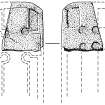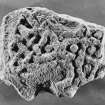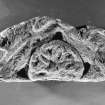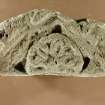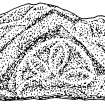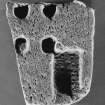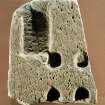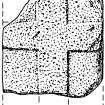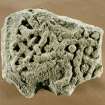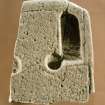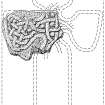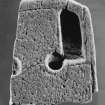St Vigeans
Cross Slab(S) (Early Medieval)
Site Name St Vigeans
Classification Cross Slab(S) (Early Medieval)
Canmore ID 35583
Site Number NO64SW 3.30
NGR NO 6383 4294
Datum OSGB36 - NGR
Permalink http://canmore.org.uk/site/35583
- Council Angus
- Parish Arbroath And St Vigeans
- Former Region Tayside
- Former District Angus
- Former County Angus
St Vigeans 29 (St Vigianus), Angus, recumbent coped monument fragment
Measurements: L 1.52m, W 0.19m, H 0.53m
Stone type: grey sandstone
Place of discovery: NO c 6384 4289
Present location: in St Vigeans Museum (HES).
Evidence for discovery: found in the late nineteenth century in the churchyard, built into some steps. Lettering and chamfer indicate that it had previously been re-used in the late seventeenth century as a lintel over a door. By 1903 it was acting as a lintel over the door of the walled garden belonging to the manse. It was taken into St Vigeans Museum in the 1960s.
Present condition: all that survives is a median slice along the long axis of the monument.
Description
The gabled roof of this originally house-shaped shrine is very steep, and an incised serpent with goggle eyes and a long snout lies along the centre of the ridge. On face A one and a half rows of concave-sided tiles survive, while at the top of face C only part of the top row of tiles survives. Geddes relates the layout of tiles to the illustration of the Temple of Jerusalem in the Book of Kells rather than to hogback monuments. Below the hacked face is inscribed M above R R above 1665. Both ends of the slab are truncated.
Date range: ninth century.
Primary references: ECMS pt 3, 280; Geddes 2017, no VIG029.
Desk-based information compiled by A Ritchie 2017.
St Vigeans 31 (St Vigianus), Angus, cross-slab fragments
Measurements: H 0.24m, W 0.20m, D 0.10m
Stone type: sandstone
Place of discovery: NO c 6384 4289
Present location: in St Vigeans Museum (HES).
Evidence for discovery: found during the1870s restoration. It was taken into St Vigeans Museum in 1960.
Present condition: weathered, two broken edges, probably trimmed for re-use.
Description
These conjoined fragments form part of the top portion of a cross-slab, carved in relief with a cross on both broad faces. The top has a rounded shape, and the slab has a wide flat-band border, on which the side-arms of the cross encroach on face A. The cross on face A has inner incised outline and rounded circular armpits. On face C the armpits are closed and the cross appears to be plain, but the surface is very worn.
Date range: eighth or ninth century.
Primary references: Geddes 2017, no VIG031.
Desk-based information compiled by A Ritchie 2017.
St Vigeans 30 (St Vigianus), Angus, cross-slab fragment
Measurements: H 0.27m, W0.26m, D 0.05m
Stone type: grey sandstone
Place of discovery: NO c 6384 4289
Present location: in St Vigeans Museum (HES).
Evidence for discovery: found during the1870s restoration. It was taken into St Vigeans Museum in 1960.
Present condition: the lower part of the slab and the top left corner are missing, and he surfaces are very weathered.
Description
A very worn outline cross carved in relief spans the slab, and the other faces appear to be plain. There may be traces of interlace within the cross, but the weathering is too severe to be sure.
Date range: early medieval.
Primary references: Geddes 2017, no VIG030.
Desk-based information compiled by A Ritchie 2017.
St Vigeans 32 (St Vigianus), Angus, cross-slab fragment
Measurements: H 0.34m, W 0.38m, D 0.04m
Stone type: sandstone
Place of discovery: NO c 6384 4289
Present location: in St Vigeans Museum (HES).
Evidence for discovery: its provenance is unknown but it was taken into St Vigeans Museum in 1960.
Present condition: poor, all edges are broken and face C lacks its surface.
Description
The relief carving on face A appears to represent the left-hand arm and much of the centre of a cross outlined by a rounded roll moulding and filled with heavy interlaced cords. Four pellets in the central area form a cross, and others appear to be randomly placed in the arm.
Date range: ninth century.
Primary references: Geddes 2017, no VIG032.
Desk-based information compiled by A Ritchie 2017.
St Vigeans 33 (St Vigianus), Angus, carved fragment
Measurements: H 0.25m, W0.55m, D 0.24m
Stone type: sandstone
Place of discovery: NO c 6384 4289
Present location: in St Vigeans Museum (HES).
Evidence for discovery: recorded in re-use in the west gable of the north aisle of the church around 1870. It was taken into St Vigeans Museum in 1960.
Present condition: worn and broken.
Description
Part of face A is carved with an incomplete marigold motif within a circle, with pellets between the petals, which is set within a sunken angular figure.
Date range: early medieval.
Primary references: Geddes 2017, no VIG033.
Desk-based information compiled by A Ritchie 2017.
Reference (1964)
NO64SW 3.30 6383 4294
No.30.
A1. Top corner of a cross-slab with plain cross on both sides. (Additional to J R Allen and J Anderson (1903)).
A2. Fragment of cross-slab with interlace. (Additional to Allen and Anderson).
A3. Fragment of cross-slab. (Additional to Allen and Anderson).
S Cruden 1964


















